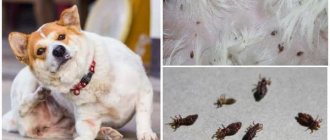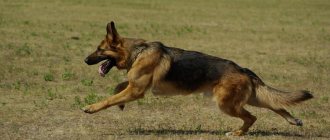Where do fleas come from in puppies?
No dog is immune to these parasites, and there are many ways a puppy can pick them up. Moreover, the older the animal, the more variants of infection there are. Here are the main ones:
- In newborn puppies, infection from the mother is most likely;
- the puppy, which was handed over to new owners, could still have eggs or larvae of the parasite, which began to multiply and pester the baby more;
- it is quite possible that the first time your pet walks outside, a flea will cling to it;
- if other animals are found in the room with the dog, then there is a chance of infection from them;
- it is possible that the parasites could transfer to the baby from the owner’s clothes or shoes;
Due to these factors, it is necessary to closely monitor the puppy and other pets, periodically checking them for the presence of bloodsuckers, so that if insects are present, treatment can be started in the early stages.
Bites
Due to their piercing-sucking apparatus, insects bite very painfully. They inject a special substance into the animal’s body that prevents blood from clotting, and enjoy the meal for about five minutes. The bite site looks like a red spot, in the center of which a dot of dried blood is visible.
The animal experiences severe itching. The dog constantly scratches the bite site and scratches the skin with its teeth. There may be wounds and scratches. This is fraught with the fact that when an infection occurs, they can develop into ulcers and ulcers.
The photo below shows what bite marks look like on a cat’s body; they are no different in dogs.
Every fourth dog suffers from bite allergies. A rash may appear all over the body. If an infection occurs, hair may begin to fall out at the site of the wounds.
The danger of fleas for puppies
For a young and unformed puppy, a flea bite is more dangerous than for an adult dog. Not only the severe itching, which bothers even older dogs, and even makes a small dog whine, but also a number of other reasons are dangerous for the baby.
- the young pet’s immune system is not yet fully formed, and they are completely defenseless against infectious agents that are transmitted by parasites through a bite;
- the puppy’s skin is still very tender and therefore will suffer more from allergic reactions to flea saliva;
- with severe infection, significant blood loss and anemia may occur;
- worms, which can be contracted from fleas, deplete the dog’s body;
If your pet often itches and bites itself, then you need to carefully examine it, and if parasites are found, immediately begin to remove them. Also, before mating, it would be better to treat the mother of the offspring with a long-acting agent so that she and the future offspring are protected during pregnancy and lactation.
Symptoms and external signs
The first and main sign that your pet has fleas is its constant scratching. He can also chew his fur. And it is possible to find out whether the puppy was really attacked by parasites only through a detailed examination. You can comb against the grain to check for the presence or absence of bloodsuckers. They usually like to be located behind the ears, as this area has thinner skin and is easier to bite.
Fleas can also be detected during water procedures. Insects will jump off the pet or try to move to drier parts of the body.
Flea saliva causes very strong allergic reactions in babies, so redness will be another symptom. Sometimes it happens that due to the negative effects of parasites, hair loss may occur. Therefore, it is worth closely monitoring changes in the dog’s behavior and appearance.
Read 10 symptoms of allergies in dogs and effective ways to treat the disease
Eggs
The female flea does not usually lay her eggs on the animal. After the pest has had enough, it leaves the dog’s body. Every day one individual lays up to 12 eggs. They do not nest and leave eggs wherever they need to. Eggs can be on the floor, under carpets, animal bedding, and even on its fur.
Flea eggs:
- white;
- oblong shape;
- size no more than one millimeter.
It is very difficult to detect them with the naked eye due to their small size. You can see them only when there are a huge number of them. Below are photos of flea eggs.
Features of treatment for puppies
When choosing a drug that will relieve the problem, you need to take into account the age of the baby. The younger he is, the less aggressive the components in the shampoo or drops should be, so as not to further damage or dry out the baby’s skin. In the first 6-8 weeks of his life, it is better to use simple methods of control; they will not be so effective, but safe for health.
To remove fleas from a puppy, it is important not only to use a special product, but also to clean the room at the same time. If there are other pets in the house, they should also be checked for insects.
Fleas on a 1 month old puppy
For a one-month-old puppy, even the most famous companies do not produce products to combat uninvited guests. You should not buy shampoo for older newborns; it is better to opt for traditional and mechanical methods:
- The first way is to bathe the puppy in a strong decoction of wormwood, tansy, wild rosemary or mint. Be sure to ensure that the drops do not get into the ears, nose and eyes. You need to keep your dog in this bath for at least 15 minutes. If all the offspring are infected, then bathe each puppy separately. After bathing and drying, the coat must be thoroughly combed over white paper or cloth to remove any fallen fleas;
- the second method is similar to the first, only using tar soap, which also has a pungent and repellent odor. First, wet the puppy with water and soap it generously, then freeze in a towel and a warm blanket so that he does not freeze, and hold this “mask” for at least 20 minutes. After this time, thoroughly rinse off the foam along with the dead fleas and do not forget about control combing , as in the previous paragraph;
Active ingredients such as herbs and tar will not harm the baby's skin and will not cause irritation or an allergic reaction, even if the puppy is only 2 weeks old. Therefore, they can be used for two-week-old babies and even newborns. But we must not forget about their mother - the main source of trouble.
Fleas on a 2 month old puppy
At this age, the feeding period has already ended and the offspring already have a more developed immune system, milk teeth and a strong physique. Therefore, it will be easier to exterminate fleas from such a puppy, since long-term preventive measures can be used.
- For this age, companies produce a large number of shampoos, but up to six months it is better to choose drugs with a minimum content of poisons, or better without them at all;
- Now you can buy collars designed for puppies and soaked in essential oils. But such a remedy will be ineffective if there are several puppies in the house due to the fact that they will chew each other’s collars and render them unusable;
- drops on the withers should be used based on the instructions and the age of the baby. Again, this method is suitable for a puppy living separately, since others may get poisoned;
- It is possible to use a spray that allows you to quickly and completely remove parasites, which are again allowed for this age. But, as with other products containing insecticides, they are contraindicated in litter.
Read Signs and treatment of ataxia in dogs: 3 types of disease
That is, if the baby is one of the animals in the house, then all these means are suitable. But if there are two or more of them, then you should be more careful when choosing a flea treatment method.
Fleas on a 3 month old puppy
For dogs of this age, most insecticidal preparations against parasites, which can be easily found in pet stores, are suitable. You can use shampoos and sprays without fear, but again you need to take into account your age. Collars will not be very effective because the puppy has already increased in size and, perhaps, the coat has become longer and thicker.
Important conditions to resolve the problem
Important conditions for eliminating parasites include:
As soon as fleas are discovered, it is necessary to take measures to eliminate them as soon as possible
If you hesitate, then after 1.5 weeks their number can increase up to 10 times. When choosing a product, it is recommended to consult a veterinarian, who will select the best option for the animal depending on its condition and age. It is very important to follow the instructions for the drug exactly - this will avoid poisoning and other health problems. It is important to use an integrated approach to flea removal: you need to not only treat the pet itself, but also the room
It is recommended to combine industrial insecticides and traditional methods
It is important to use an integrated approach to flea removal: you need to not only treat the pet itself, but also the room. It is recommended to combine industrial insecticides and traditional methods
The best flea remedies
There is a wide range of flea control products on the market. The main thing is to choose a product according to the puppy’s age and pay attention to its composition. You can rid your puppy of fleas with special shampoos, drops or sprays.
Shampoos
Zoo shampoos for puppies are made from natural ingredients with the addition of insecticides, which kill parasites. The shampoo is gentle on the skin, making it suitable for use on small pets. In just a few baths you can get rid of bloodsuckers, and as a bonus, this product takes care of the baby’s skin and coat. Such drugs are the safest, so there are more of them than drops and sprays. Here are some of them:
- Beaphar is a product from a Dutch company that includes permethrin and is suitable for dogs of any coat length;
- Phytoelite - consists of herbal extract and a small dose of permethrin;
- Celandine - contains essential oils and insecticide.
The shampoo is applied to damp hair, foams and lasts for about 5 minutes. Rinse off the foam well, rinse the wool and dry. As an addition, after this procedure you can comb your pet.
Drops
This drug is best used from the age of two months and if the pet is alone in the house. The product also contains insecticides, which are the active substance against parasites. It is applied to the puppy’s skin, spreading the fur, and to places inaccessible for licking. This procedure does not take much time and provides prevention against infection for a period of one to two months. The safest for puppies:
- Frontline spot - active substance - fipronil, recommended for use for pets over two months old, provided that its weight is more than 2 kg;
- Celandine drops - like shampoo, contain essential oils, but with the addition of fipronil;
There are other names of drops: “Bars Forte”, “Advocate”, “Practician”, which can be used to treat a puppy. Before use, be sure to read the composition and instructions.
Sprays and aerosols
They are good because they are easy to apply, work quickly and are highly effective. The spray kills fleas within a few minutes and protects against re-infestation. Before use, shake, apply to the entire body against the growth of the coat, slightly moisturize it. Processing must be carried out in a well-ventilated area or outdoors.
Read When and what vaccinations to give to puppies up to one year old (table)
It is better to choose certified sprays and aerosols that have passed quality and safety control. These include:
- Stronghold - contains selamectin, which destroys flea larvae, suitable for puppies over 1.5 months of age;
- Frontline - can be used even for the smallest ones, the number of presses on the spray can depends on the weight and length of the fur (a calculation table is included in the kit);
- Leopard - contains fipronil and protects the puppy for 30 days from all types of blood-sucking insects.
After application, do not allow your pet to lick itself and refrain from water treatments for the next 2 days.
Anti-flea collars
Typically used to prevent parasite infection. The collar is simply put on the pet’s neck and left for several months; it has a fairly long insecticidal effect. But if the puppy has sensitive skin, then it is quite possible that he will have an allergic reaction from wearing such an accessory. Typically suitable for animals over 10 weeks of age. Market leaders:
- HartZ - contains tetrachlorvinphos, which belongs to the third safety class, suitable for 1.5-2 months of age;
- Beaphar - has the same characteristics and active ingredient.
The collar will be effectively used in combination with another product, for example, shampoo.
Traditional methods
They were mentioned a little earlier, as they are applicable for newborn babies. Traditional methods are based on the use of herbs. That is why they are so harmless for newly born puppies.
If the mother and offspring are in an enclosure or in a room separate from human habitation, then it would be good to place bunches of herbs such as wormwood, lavender, and bugs around the bed. They have a pungent odor that will repel nasty insects. For the convenience of animals, the bunches can be replaced with powder from the same plants. Herbs are safe even for babies, who may accidentally get the herb inside.
If animals live in the house, then the litter and the surrounding area should be treated with water with the addition of a couple of drops of essential oil of the same lavender, lemon, menthol or eucalyptus. This method also has a deodorizing and antimicrobial effect.
Do not forget about baths using herbs that have a pungent and repellent odor.
Larvae
The larvae appear 14 days after the flea lays its eggs. A person will not be able to notice them, since they are very small in size.
What does a flea larva look like:
- small size – 0.5-1 mm;
- white.
Newly hatched larvae avoid sunlight. They feed on waste from other fleas, particles of human and animal skin. They can be confused with fly larvae, since the slightly grown ones resemble worms.
They develop after hatching from the egg for about 20 days. They have to go through several stages of pupation before they develop into real fleas. After three weeks, they can already mate and leave offspring.
It is extremely rare to find a larva on an animal's fur. This only happens when the dog's body is oversaturated with these parasites. The photo below shows flea larvae.
Prevention
After a long fight against pests, you don’t want them to come back. Therefore, you should follow basic measures that will protect not only a small puppy, but also an adult dog from infection:
- avoid allowing the animal to come into contact with stray animals;
- regularly inspect your pet and periodically treat it with flea repellents;
- after getting rid of parasites, it is necessary to thoroughly vacuum the area and treat the surrounding area;
Fleas are not the worst thing that can happen to a pet; this phenomenon is quite common. The main thing is to notice this in time and begin effective treatment. It is necessary to carefully select the product; as you can see, they are quite varied and are not suitable for everyone. It is worth being patient and willing to help your pet, because no one except the owner will save him from endless itching and bites. Because we are responsible for those we have tamed.
Important conditions to resolve the problem
At first glance, it may seem that removing fleas from a dog at home is very simple, but this is not entirely true. It is necessary to carry out treatment taking into account individual conditions that will effectively remove parasites without causing harm to the pet. Ideally, you need to consult with a specialist who will rule out the presence of ticks and tell you in detail how to rid your dog of fleas. But, knowing about the features of treatment, the owner will be able to cope with this problem on his own.
Important conditions for ridding animals of fleas:
- If parasites are detected, it is necessary to immediately carry out appropriate procedures to combat them, since the main feature of fleas is rapid reproduction. Already 2 weeks after infection with 1 individual, their number can increase to several dozen.
- In veterinary pharmacies there is a wide range of different drugs to eliminate this problem. The effectiveness of treatment depends on how correctly the remedy is selected.
- An important condition for eliminating parasites is compliance with the application specifications specified in the instructions. An incorrect dosage of the drug may not have a positive effect or may harm your pet.
- Compliance with preventive measures after treatment significantly reduces the possibility of re-infection of the dog.
It should be remembered that there is no method by which one could get rid of fleas forever, because even careful adherence to preventive measures will not help protect against re-infestation. Therefore, you can use specialized flea products for dogs more than once.











